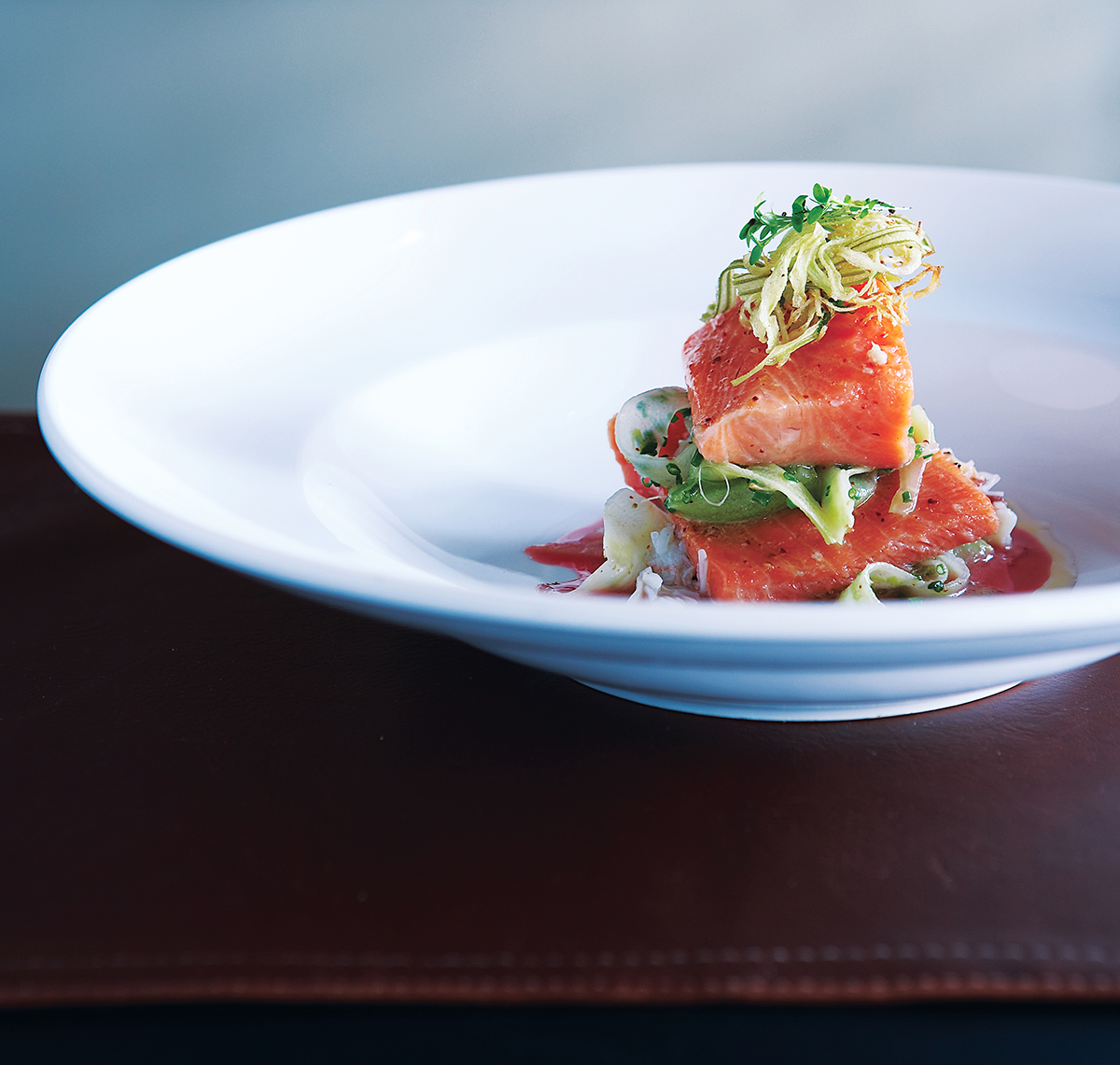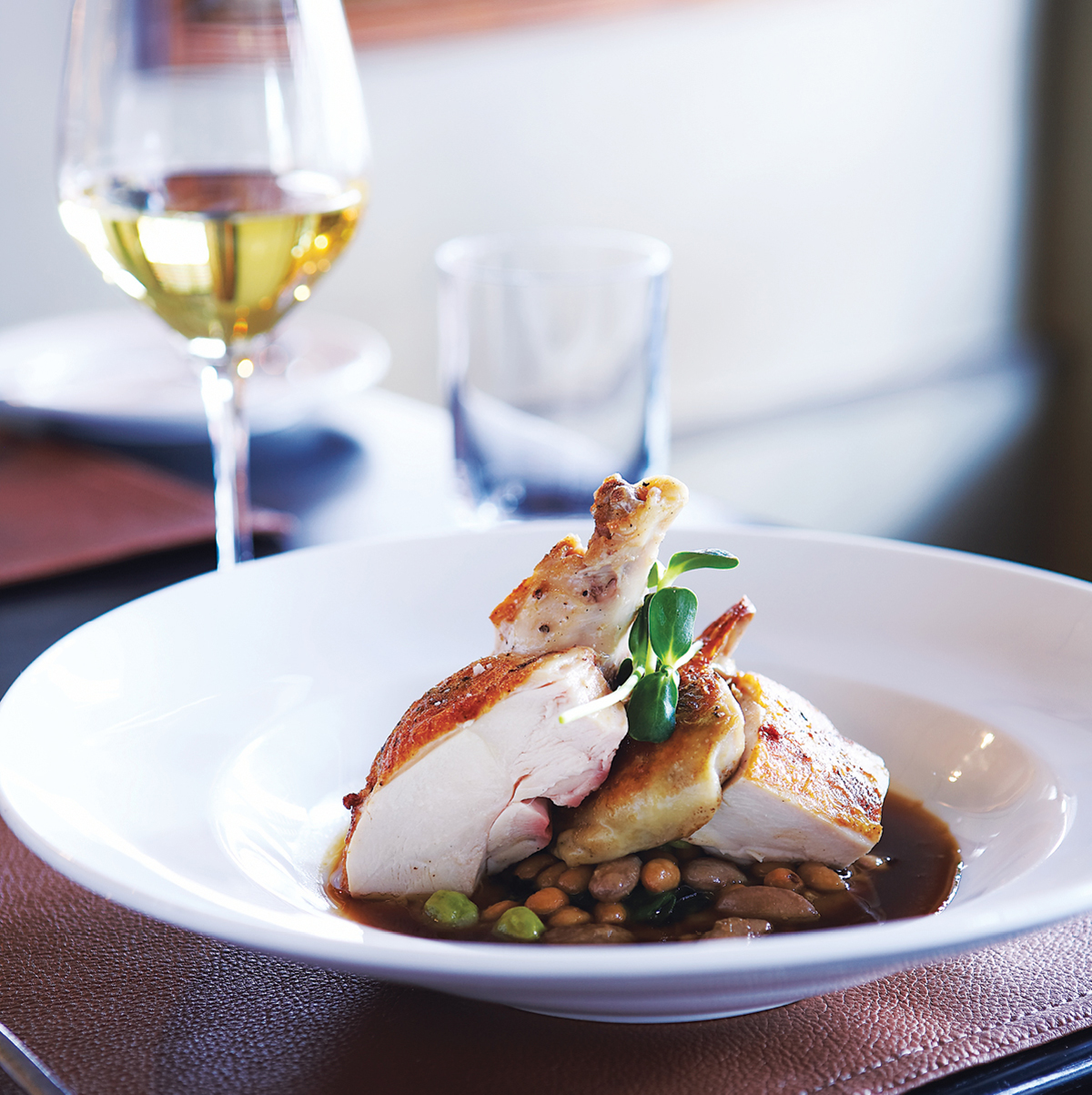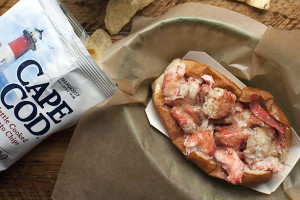Dining Out: Craigie on Main

The sea trout mi-cuit (semicooked) with fennel-celery salad in a pool of citrus emulsion. (Photograph by Keller + Keller)
Now that Tony Maws has moved his gem of a bistro—Or “Bistrot,” as he insisted on spelling it—from the outer reaches of Harvard Square to much larger premises, it can finally (and gladly) shed its reputation as a secret haunt solely for in-the-know gourmands. For starters, there are twice as many seats at Craigie on Main, in the far less sniffy reaches of Central Square. There’s also a bar with a new, lower-priced menu, and—front and center—an open kitchen shining with dream equipment Maws salvaged on a four-state tour.
It would be easy to have a good meal every night in the immediate vicinity: Rendezvous and Salts, two other exceptional chef-owned restaurants, are steps away; the ever-reliable Central Kitchen is within short walking distance; and Hungry Mother and Oleana aren’t so far, either. (Take that, South End!)

Chef Tony Maws, in his recently relocated (and renamed) bistro. (Photography by Keller + Keller)
I both celebrate the move and miss the intimacy of the old place—I have no small amount of nostalgia for the curvy Parisian red leatherette banquettes and the cute café curtains masking the view of the parking lot. Still, it’s great to see the business Craigie is getting for a menu whose prices haven’t dropped: appetizers around $15, entrées around $30. As practically nowhere else does these days, the new Craigie makes you look around and ask, “What recession?” But all that shiny, souped-up equipment has Maws understandably running free, and sometimes a bit wild.
Glories there are aplenty. Maws is a meat man, and the talent for charcuterie that snapped me to attention at Craigie Street Bistrot is on full display here. It would be a crime against dining (though not against vegetarianism) to leave without polishing off the assiette of three terrines ($15), which change but generally include headcheese (a lovely jellied mosaic), fantastically rich-flavored country pâté, and spreadable, unctuous four-liver pâté so good that bread just gets in the way. Maws has a fondness for using pork jowl and bits from the head and foot, saving the liver from every animal that comes through the door, and curing his own bacon—the basic French thrift of eschewing waste, and splurging only on some Armagnac for steeping. These are lessons for any chef, and mind and palate openers for any silly, squeamish eaters.

slow-roasted organic Vermont chicken. (Photograph by Keller + Keller)
One favorite Bistrot dish, the slow-roasted organic chicken ($25), is even better than I remembered. In fact, it’s downright superb. This might be because Maws has found a farm in Vermont, Misty Knoll, that raises what he says are some of the best chickens he’s ever had. Or because the “slow roasting” is actually a gentle poaching of the breast (which has been expertly brined) in duck fat in a sous-vide vacuum immersion cooker, and a slow confit of the thigh (which gets several days of curing and weeks of steeping beforehand). Along with the terrines, the dish goes permanently in Boston’s hall of fame. It’s certainly the first time I’ve ever liked anything cooked by sous vide, which generally turns respectable proteins to baby food.
Maws employs another innovative technique to exemplary results, “half-cooking” sea trout mi-cuit ($30) in a newfangled low-temperature oven with injected moisture. As with sous vide, the fish looks raw (though it’s been cooked just to the safety point), which will no doubt put off some diners. But the flavor is focused, and in Maws’s hands the technique makes a dullish fish seem new and even sublime. A citrus emulsion points up that flavor, and fennel-celery salad gives the dish texture and richness.
Other uses of new flavors and technology are less successful. Poaching sweetbreads in yogurt to tenderize them does provide both a milky sweetness and some tang, but also a texture I found too soft. And everything on the plate fell into a blur, even if I did get why each component was there: cashews for crunch, tangerines and dried plums for acid and chew, pioppini mushrooms and a reduction sauce of Barolo chinato (a bittersweet digestif) for depth.
Maws is on a new quest, one that this dish fully illustrates: He’s in love with umami, the so-called “fifth taste,” a flavor best described as savory and tongue-coating. Thus he spikes a squid ink, anchovy, and garlic sauce with umami-rich dried miso powder in an appetizer of perfectly deep-fried Nova Scotia smelts ($14). He also throws miso into a beef jus–red wine reduction under thin slices of nicely pan-roasted hanger steak, shiitakes, and (terrific) confited and crisped dice of smoked beef tongue ($36). The sauce is thickened with, get ready, puréed foie gras and walnuts, the steak topped with deep-fried shallots and bone marrow. Whew! You need several bites just to figure out everything going on—it’s umami overload.

SCOOPing to conquer: Profiteroles with house-made banana ice cream and Valrhona chocolate sauce. (Photograph by Keller + Keller)
Dessert settles into more of a comfort zone, with the fruit crisps and bread pudding variations from the Bistrot and a few surprises, like the rum-spiked chocolate pooling over the profiteroles filled with roasted banana–muscovado ice cream ($10).
I’d say that Maws has his own brand of umami, even without all the miso and the new flavor concentrations. His careful choice and manipulation of ingredients and outright cooking talent already do the flavor-concentrating work for him—as the economy-defying Craigie on Main keeps proving every packed-full night.
Critic Corby Kummer—an editor at The Atlantic and author of The Pleasures of Slow Food—has been reviewing Greater Boston’s top restaurants in our pages since 1997.


